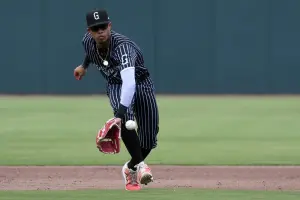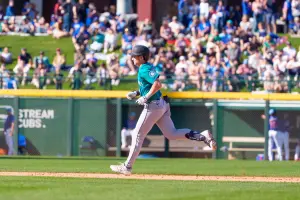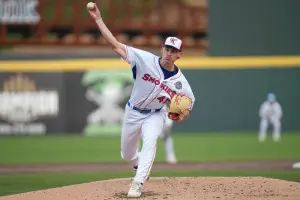
(*) MINORS: The Eyes have it—Low-A Braves Albies, Toussaint
The Atlanta Braves' metamorphosis started in September 2014 when they fired General Manager Frank Wren and eventually hired John Hart to lead the organization in a new direction. Focused on infusing the organization with young talent, Hart and top lieutenant John Coppolella unloaded Jason Heyward, Justin Upton, Evan Gattis, B.J. Upton, Craig Kimbrel and others to the highest bidders. In return, they acquired prospects ranging from MLB ready pitchers Matt Wisler and Mike Foltynewicz, to prospects further away from making their debuts, like Max Fried and Ricardo Sánchez. In a short time, the Braves went from having a few top prospects (José Peraza, Lucas Sims and Braxton Davidson) to an organization with a slew of them.
The Rome Braves (Single-A) have been the biggest beneficiary of the Braves' influx of young talent. Earlier this season, a scout estimated that Rome had 11 or 12 potential MLB players on its roster. And that was before Atlanta acquired—and then assigned to Rome—RHP Touki Toussaint from Arizona. In other words, it's the most talent on Rome since 2010. Let's take a look at the most buzzed about R-Braves prospects, shortstop Ozhaino Albies (#44 on the m9d-season Top 50 prospect list) and pitcher Touki Toussaint (#ranked #8 in our offseason ARI report).
Ozhaino Albies (SS, ATL)
Braves #5 prospect (pre-season)
Dates Seen: 5/17/15 & 6/28/15
Ozhaino Albies' stock is skyrocketing. The 18-year-old shortstop from Curacao is making full season ball look easy. The switch-hitter is slashing .334/.388/.427 in the South Atlantic League against competition generally four to five years older. He peppers line drives to all fields, showing power to the gaps. Though despite his success, there are some concerns.
Albies is approximately two inches shorter than his listed 5'9'' height; he is tiny. I'm surprised writers and scouts aren't holding his height against him in evaluations. Maybe Jose Altuve opened up doors for guys like Albies, though he is built differently than Altuve. Albies doesn't yet have the sturdy base that helps Altuve grind through a 162 game season. He is slim, maybe 135 lbs soaking wet. Without a growth spurt, his slender frame doesn't provide much room to add muscle—maybe an additional 10 pounds, tops. And any added bulk beyond that may depreciate his plus-plus run tool.
Albies is a competent defensively. He has a plus arm, and at maturity, will make all the plays of an MLB-average shortstop. He has soft hands and flows through the ball, but struggles with poor footwork, which is common for young infielders. He projects as the third-best defensive shortstop in the organization, behind Gold Glove award winning Andrelton Simmons, and Triple-A second baseman José Peraza. Having scouted Peraza at the same point in development, he had more range and better footwork, but lacked Albies' plus arm.
Albies doesn't project for much power, but the kid can hit. His skill set reminds me of former all-star Luis Castillo. Like Castillo, he is effective from both sides of the plate, has a knowledge of the strike zone and features elite bat control. Albies is less of a slasher. In the video package, notice how quick he reacts to the pitch. Quick wrists, soft hands and a compact swing aid his incredible hand/eye coordination. Albies' biggest attribute is how he uses elite bat control to his advantage.
A lot of prospects with plus (or higher) bat control have little idea of how to employ it. For instance, Mets infielder Wilmer Flores, at the same point in development, would make loads of contact. However, it was rarely good contact. He'd barrel a middle-in fastball to left field one at-bat, but then feebly groundout to short on pitches away the next two at-bats. Like Flores, Albies barrels middle-in fastballs but his advanced instincts allow him to lay off the pitch away or take it to the opposite field for a hit. It's no wonder he bats .330 from both sides of the plate.
For an 18-year-old prospect, Albies is a medium-risk investment for a owner looking to develop a specific skill set. During his prime, Luis Castillo slashed .300/.380/.370 with about 30 extra base hits and 40 steals per season. Albies has potential to slug at a bit higher rate. He could potentially be a major leaguer at the age of 20, but given some of this shortcomings, fantasy owners shouldn't expect real production from him for three to four years.
Touki Toussaint (RHP, ATL)
Diamondbacks #8 prospect (pre-season)
Dates Seen: 6/28/15
Touki Toussaint wasn't on my scouting radar this season. Toussaint was playing for South Bend, the Midwest League affiliate of the Arizona Diamondbacks. At BaseballHQ, the Midwest League is Jeremy Deloney's and Rob Gordon's domain. Unexpectedly, the Diamondbacks traded Toussaint to Atlanta in mid-June, the reward for taking on Bronson Arroyo's $10M contract obligation. Making his organizational debut with Rome in late June, I joined about a dozen scouts to scout the righthander.
Toussaint is a beast of an athlete—the sort of athlete baseball often loses to football. Listed at 6'3'', 185 lbs., the former 1st round pick is an intimidating sight on a Sally League mound. Broad through the shoulders and thick at the base, Toussaint has a body scouts dream on. His frame can easily handle an additional 15-20 lbs. of lean muscle during development.
Extremely raw, Toussaint is learning consistency. For any pitcher, a successful pitch starts with a controlled leg lift. It enables a pitcher to gain balance before pushing forward and delivering the ball. Toussaint struggled to gain balance on pitches due to a jerky leg lift. Rushing to the plate forces a pitcher's arm to play catchup with his lower half, sacrificing command and control. As evident during a few pitches in the video package, Toussaint loses his release point when forced to play catch-up from his balance point.
Toussaint's arsenal of pitches include two potential plus offerings, a 91-92 mph fastball and a 74-75 mph curveball. He complements those with change-up and a slider. When Toussaint throws the fastball from the correct slot, it's untouchable—incredibly heavy and with a late arm-side bore; a true swing-and-miss offering. However, when Toussaint loses his release point, he has no control of the pitch. Giants prospect Johneshwy Fargas found out the hard way, getting hit by two errant fastballs in the game. As Toussaint irons out flaws in his delivery and adds more strength, expect this pitch to play up tremendously.
The curveball debuted late in Toussaint's appearance. It has the best potential of any curveball I've ever scouted in the Sally League. The 12-6 break devastates hitters with no pronounced wrist wrap. The lone issue was that Toussaint slowed down his mechanics during the delivery of a slower variation of the pitch. In the upper levels, hitters will pick up on the slowed delivery, and he will be exposed quickly.
The change-up made a few sporadic appearances against the lone left-handed hitter in the lineup. Lacking arm-side run, the 84-85 mph pitch benefited from the same downward angle of the fastball. The pitch had solid deception, and Toussaint commanded it better than his fastball. The last pitch from behind home plate in the video package is a change-up that fell off the table. Building on the deception this pitch creates is key its long-term success. This could become a plus pitch as he irons out the wrinkles in his delivery, and improves the command of his fastball.
Currently, Toussaint's slider is inconsistent. It's either a slow cutter (thrown at 85-86 mph) or a short one-plane slider (at 82-84 mph). It was effective against a very weak hitting Augusta lineup, but would not play at the higher levels. As such, a future for this pitch is difficult to project.
At 19, Toussaint is at least three seasons away from a major league shot, so there's much development time ahead. He has the stuff to be a #1/#2 starter, providing high strikeout rates for fantasy owners, but his lack of command is a major concern. In this case, an issue this pronounced likely doesn't ever completely go away. For instance, take Edwin Jackson, a good pitcher who never lived up to his stuff because of shoddy command. A more likely outcome for Toussaint, then, is a #3/#4 starter who never reaches potential—which is less than the top-flight starter Braves fans, prospect followers and fantasy owners are hoping for.









